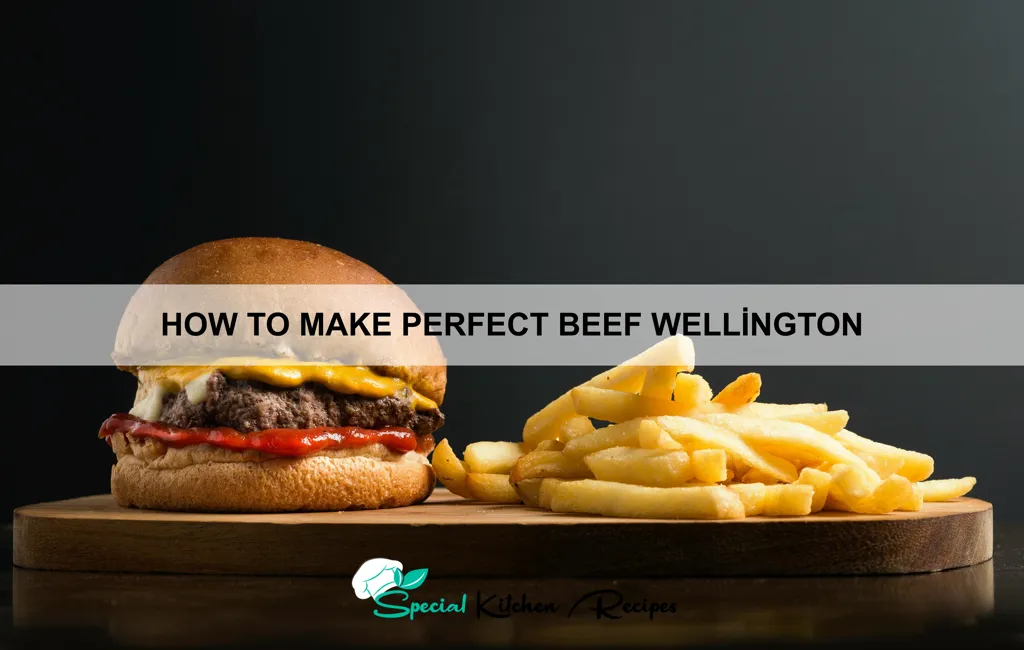Beef Wellington, a culinary masterpiece that graces tables at Michelin-starred restaurants and ambitious home kitchens alike, boasts a surprisingly rich and intriguing history. While its exact origins are debated, the dish’s current form is widely believed to have emerged in the 19th century in England, possibly as a playful twist on classic French techniques. The name itself is a nod to the 1st Duke of Wellington, Arthur Wellesley, a prominent figure in British history, though no definitive link exists between the man and the dish. The dish’s enduring popularity speaks to its inherent elegance and the impressive culinary skill it showcases.
The layered construction of Beef Wellington – a tender beef tenderloin encased in duxelles (a finely chopped mushroom paste), wrapped in Parma ham or prosciutto, and finally cloaked in puff pastry – is a testament to the artistry of classic French cuisine. The dish’s complexity and the precision required in its preparation have made it a benchmark of chef proficiency. It’s not just about the individual components; it’s about the harmony they create, the interplay of textures – the crisp pastry, the savory ham, the earthy mushrooms, and the succulent beef – that elevate it beyond a mere meal. A perfectly executed Beef Wellington is a symphony of flavors and textures.
Beyond its technical challenges, Beef Wellington holds a significant cultural position. It’s frequently featured in celebratory meals, formal dinners, and special occasions, often representing a pinnacle of culinary achievement. Its presence on a menu often signals a commitment to quality and sophistication. While precise statistics on its global consumption are hard to come by, its prominence in high-end restaurants and its frequent appearance in cooking competitions and television shows indicate a sustained and widespread appreciation. The dish’s visual appeal, with its golden-brown pastry and impressive size, also contributes to its popularity, making it a striking centerpiece for any gathering. Mastering Beef Wellington remains a significant accomplishment for any home cook, offering a taste of culinary history and a chance to impress even the most discerning palates.
Ingredients and Measurements
Creating the perfect Beef Wellington requires precise measurements and high-quality ingredients. Don’t skimp on the quality; it directly impacts the final flavor and texture. Here’s a detailed breakdown of what you’ll need for a Beef Wellington serving approximately 4-6 people:
Beef: 1.5 lbs (680g) of beef tenderloin, trimmed of all silver skin and excess fat. Choose a center-cut tenderloin for the most consistent texture and tenderness. Ensure the beef is at room temperature before searing – this allows for even cooking.
Duxelles (Mushroom Paste): 8 oz (225g) cremini mushrooms, finely minced; 4 oz (115g) shallots, finely minced; 2 cloves garlic, minced; 4 tbsp (60g) unsalted butter; 2 tbsp fresh thyme leaves; 1 tbsp fresh parsley, chopped; Salt and freshly ground black pepper to taste. The key to a great Duxelles is thorough cooking to remove excess moisture. Don’t rush this stage; the drier the Duxelles, the better it will hold its shape.
Parma Ham or Prosciutto: 8-10 slices of high-quality Parma ham or Prosciutto, overlapping slightly to create a smooth, even layer. Ensure the slices are large enough to completely cover the beef tenderloin. The saltiness of the ham complements the richness of the beef beautifully.
Puff Pastry: 1 sheet (14.1 oz/400g) of high-quality all-butter puff pastry, thawed according to package instructions. Work quickly with the puff pastry to avoid it becoming too soft. Keep it chilled until ready to use. If your pastry sheet is too small, use two smaller sheets, carefully patching them together with a little water.
Egg Wash: 1 large egg, beaten with 1 tablespoon of water. This will help the pastry to brown beautifully and create a glossy finish. Apply the egg wash just before baking.
Optional additions: A thin layer of Dijon mustard between the beef and the ham can add a nice tangy flavour. Some chefs also add a layer of finely sliced truffles to the Duxelles for an extra luxurious touch. Remember to adjust the seasoning throughout the process to your personal preference.
Important Note: All ingredients should be fresh and of the highest quality possible. The success of your Beef Wellington heavily relies on the quality of your starting ingredients. Precise measurements are crucial for achieving the perfect balance of flavors and textures.
Beef Preparation (including searing)
The success of your Beef Wellington hinges significantly on the preparation of the beef itself. We’ll be using a center-cut tenderloin, approximately 1.5 – 2 lbs, for optimal results. Ensure your beef is completely dry before beginning. Pat it down thoroughly with paper towels; any excess moisture will hinder the searing process.
Season generously with salt and freshly cracked black pepper. Don’t be shy! About 1 ½ teaspoons of kosher salt and ½ teaspoon of freshly cracked black pepper should suffice for a 2 lb tenderloin. Seasoning should be applied liberally to all sides of the beef.
Next comes the crucial searing step. Heat a heavy-bottomed skillet, preferably cast iron, over high heat until it’s screaming hot. Add 2 tablespoons of high-smoke-point oil, such as grapeseed or canola oil. The oil should be shimmering before adding the beef.
Carefully place the tenderloin in the hot skillet. Sear for 2-3 minutes per side, allowing a beautiful, deep brown crust to develop. Do not overcrowd the pan; if necessary, sear in batches to ensure proper browning. Avoid moving the beef around excessively during searing; let it develop a good crust before flipping.
Once seared, remove the beef from the skillet and place it on a wire rack to allow it to cool slightly. This is important for two reasons: it allows the beef to rest and retain its juices, and it prevents the duxelles from becoming soggy during the assembly process.
Use a meat thermometer to check the internal temperature of the beef. The ideal internal temperature for a rare tenderloin is 125°F (52°C). If you prefer medium-rare, aim for 130-135°F (54-57°C). Remember that the beef will continue to cook slightly as it rests, so take this into account.
Once the beef has reached your desired temperature, remove it from the heat and let it rest completely before proceeding with the rest of the Wellington assembly. Allowing the beef to rest is essential for ensuring a tender and juicy final product. While it rests, prepare your duxelles and pastry.
Duxelles Preparation (Mushroom Mixture)
The duxelles is a crucial component of Beef Wellington, contributing both flavor and texture. A well-made duxelles is earthy, rich, and subtly savory, providing a delightful counterpoint to the richness of the beef. This recipe will guide you through creating the perfect duxelles for your masterpiece.
Ingredients:
- 1 pound cremini mushrooms, finely chopped (about 4 cups)
- 1/2 cup finely chopped shallots
- 2 cloves garlic, minced
- 4 tablespoons (1/2 stick) unsalted butter
- 2 tablespoons fresh thyme leaves
- 1/4 cup dry sherry (optional, but adds depth of flavor)
- Salt and freshly ground black pepper to taste
Instructions:
1. Sauté the aromatics: Begin by melting the butter in a large skillet over medium heat. Add the shallots and garlic and cook, stirring frequently, until softened and translucent, about 3-5 minutes. Avoid browning the shallots, as this can impart a bitter taste.
2. Cook the mushrooms: Add the chopped cremini mushrooms to the skillet. Increase the heat to medium-high and cook, stirring occasionally, until the mushrooms release their moisture and begin to brown, about 8-10 minutes. This process is crucial for removing excess moisture and developing deep mushroom flavor. Don’t overcrowd the pan; work in batches if necessary to ensure even cooking.
3. Deglaze (optional): If using sherry, pour it into the skillet and scrape up any browned bits from the bottom. Let the sherry reduce slightly, about 1 minute. This adds complexity and depth to the duxelles.
4. Season and finish: Stir in the fresh thyme leaves, salt, and pepper. Cook for another 2-3 minutes to allow the flavors to meld. Taste and adjust seasoning as needed. The duxelles should be well-seasoned but not overly salty.
5. Cool and dry: Transfer the duxelles to a baking sheet lined with parchment paper. Spread it out in a thin, even layer to cool completely. This helps to remove excess moisture and prevent a soggy Beef Wellington. Once cool, the duxelles can be stored in the refrigerator for up to 2 days.
Professional Tip: For an even richer flavor, consider adding a tablespoon of finely chopped fresh parsley along with the thyme. Also, using a combination of mushroom varieties, such as shiitake or oyster mushrooms, can add interesting textural and flavor nuances.
Pastry Preparation (including blind baking)
The pastry is crucial to a successful Beef Wellington; a soggy bottom is a culinary crime! We’ll be using ready-made puff pastry for convenience, but the principles remain the same for homemade versions. Choose high-quality, all-butter puff pastry for the best results. You’ll need approximately 400g of ready-rolled puff pastry, enough to comfortably encase your beef. Remove it from the refrigerator at least 30 minutes before use to allow it to soften slightly.
Before working with the pastry, ensure your work surface is lightly dusted with flour to prevent sticking. Gently unfold the pastry and, if necessary, lightly roll it out to create a larger, more even rectangle. Aim for a rectangle that’s approximately 1cm larger than the beef fillet on all sides. This extra space is essential for creating a neat, sealed parcel.
Blind baking the pastry shell is vital for preventing a soggy bottom. This involves pre-baking the pastry before adding the filling. To begin, prick the pastry all over with a fork to prevent it from puffing up unevenly during baking. Then, line a baking sheet with parchment paper. Lay the pastry on the parchment paper.
Blind baking is key to a crisp pastry. To do this, line the pastry with baking parchment and fill it with baking beans or rice. This prevents the pastry from rising during baking. Bake at 180°C (350°F) for 15-20 minutes, or until the edges are lightly golden. Carefully remove the baking beans and parchment paper. Return the pastry shell to the oven for another 5-7 minutes, or until it’s lightly golden brown and completely dry. This final step ensures a crisp base.
Important Note: Don’t overbake the pastry; it should be golden, not brown. Overbaking will result in a hard, brittle crust. Once blind baked, allow the pastry to cool completely before proceeding with assembling the Beef Wellington. This prevents the pastry from becoming soggy from the moisture of the filling.
Once cooled, the blind-baked pastry shell is ready to receive the seasoned and layered beef, duxelles, and Parma ham. Remember to work quickly and efficiently to avoid the pastry becoming too warm and soft. Keep any unused pastry covered with a damp cloth to prevent it from drying out.
Wellington Assembly
The assembly of the Beef Wellington is arguably the most crucial and delicate stage. A well-executed assembly ensures a perfectly cooked, beautifully presented dish. Here’s a step-by-step guide to achieving Wellington perfection.
Prepare your work surface: Ensure your work surface is clean and dry. Having everything prepped and ready to go will prevent the pastry from becoming too warm and soft.
Layering the components: Begin by laying out a large sheet of cling film (approximately 20 inches x 15 inches). Place your perfectly seasoned and seared beef fillet (approximately 1.5 lbs, trimmed of any excess fat) in the center of the cling film. The fillet should be completely cool before proceeding.
The duxelles layer: Spread a generous layer of finely chopped duxelles (approximately 1 cup, made from finely diced mushrooms, shallots, thyme, and butter) evenly over the top of the beef fillet. Ensure the duxelles completely covers the fillet, leaving no gaps. Avoid using too much duxelles; this can lead to a soggy Wellington.
The Parma Ham layer: Next, carefully lay overlapping slices of Parma ham (approximately 6-8 ounces) over the duxelles layer. The Parma ham helps to bind the duxelles to the beef and adds a layer of flavour and richness. Ensure the Parma ham completely covers the duxelles.
Tightly wrapping the beef: Using the cling film, tightly wrap the beef, duxelles, and Parma ham into a neat, cylindrical parcel. Twist both ends tightly to secure the filling. This helps maintain its shape during cooking. Refrigerate for at least 30 minutes to allow the layers to firm up and make handling easier.
Pastry application: On a lightly floured surface, gently roll out your puff pastry (one sheet, approximately 14×10 inches) into a large rectangle. The pastry should be slightly larger than the beef parcel. Carefully unwrap the beef parcel and place it centrally onto the pastry.
Encasing the Wellington: Using a pastry brush, lightly brush the edges of the pastry with egg wash (one egg beaten with a tablespoon of water). Fold the pastry over the beef, tightly enclosing it completely. Crimp the edges firmly to seal, ensuring no air pockets remain. Use a fork to crimp the edges for a professional finish.
Egg wash and scoring: Brush the entire surface of the Wellington with egg wash. This will give it a beautiful golden-brown finish. Use a sharp knife to score the top of the pastry, creating decorative lines. This allows steam to escape during cooking, preventing it from bursting.
Final preparation: Place the assembled Wellington onto a baking tray lined with baking paper. Refrigerate for at least another 30 minutes before baking. This allows the pastry to firm up and provides a crispier crust.
Important Note: The success of your Beef Wellington depends on the quality of your ingredients and the precision of your assembly. Take your time, and enjoy the process!
Cooking the Wellington (Oven Temperature and Timing)
Cooking a Beef Wellington perfectly requires careful attention to temperature and timing. The goal is to achieve a beautifully seared exterior, a perfectly cooked tenderloin, and a warm, crisp pastry. Getting this right hinges on understanding both your oven and the size of your Wellington.
Preheat your oven to 400°F (200°C). This high initial temperature ensures a crisp pastry crust. A lower temperature will result in a soggy bottom, which is the culinary equivalent of a tragedy. Ensure your oven is thoroughly preheated before placing the Wellington inside; use an oven thermometer for accuracy.
The cooking time depends heavily on the size of your beef tenderloin. For a 2-pound tenderloin, expect a cooking time of approximately 25-30 minutes. For a larger, 3-pound tenderloin, you’ll need closer to 35-40 minutes. These are estimates, and you should always use a meat thermometer to gauge doneness.
Crucially, do not rely solely on the timer. A meat thermometer is your best friend here. Insert the thermometer into the thickest part of the tenderloin, avoiding the bone if applicable. For medium-rare, aim for an internal temperature of 130-135°F (54-57°C). For medium, aim for 140-145°F (60-63°C), and for medium-well, aim for 150-155°F (66-68°C). Remember that the internal temperature will continue to rise slightly after you remove the Wellington from the oven (carry-over cooking), so remove it from the oven a few degrees below your target temperature.
Once the Wellington reaches your desired internal temperature, remove it from the oven and let it rest for at least 15-20 minutes before slicing and serving. This resting period allows the juices to redistribute, resulting in a more tender and flavorful Wellington. Tent it loosely with foil to retain heat during resting.
Important Note: Oven temperatures can vary, so closely monitor your Wellington’s internal temperature throughout the cooking process. Adjust cooking time as needed to achieve your desired level of doneness. It’s better to slightly undercook and let it rest than overcook and end up with dry beef.
Following these guidelines will help you create a stunning and delicious Beef Wellington that will impress your guests. Remember, practice makes perfect, so don’t be discouraged if your first attempt isn’t flawless. Keep experimenting and refining your technique, and you’ll soon master this classic dish.
Recommendations
For the perfect Beef Wellington, meticulous preparation is key. Ensure your beef tenderloin is completely dry before searing; this helps achieve a beautiful crust. Don’t overcrowd the pan when searing, as this will lower the temperature and result in steaming rather than browning. Allow the beef to cool completely before wrapping to prevent the pastry from becoming soggy. Finally, brush the pastry with egg wash before baking for a rich golden-brown finish.
Serving suggestions are endless! Beef Wellington is a showstopper, perfect for special occasions. Consider serving it with a classic red wine reduction sauce, perhaps a Cabernet Sauvignon or Merlot. A simple yet elegant side of roasted asparagus or creamy mashed potatoes complements the richness of the beef. For a more adventurous pairing, try a wild mushroom risotto or a vibrant green bean salad with toasted almonds.
Leftover Beef Wellington can be stored in the refrigerator for up to 3 days. Allow it to cool completely before wrapping tightly in plastic wrap, then placing it in an airtight container. Reheat gently in a low oven (around 300°F/150°C) until warmed through. Avoid reheating in a microwave, as this can lead to a dry texture. Do not refreeze.
Nutritional Information (per serving, approximate): Calories: 700-800 (varies greatly depending on the size of the Wellington and ingredients used), Protein: 50-60g, Fat: 50-60g, Carbohydrates: 20-30g. This is an estimate and may vary depending on the specific recipe and ingredients used. For accurate nutritional information, use a nutrition calculator with your exact ingredients and quantities.
Remember, the success of your Beef Wellington hinges on quality ingredients and careful technique. Don’t be afraid to experiment with different flavor combinations to create your own signature dish. Enjoy!





